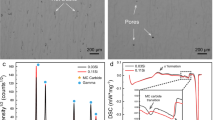Abstract
The design of a permanent Step mold for the evaluation of the mechanical properties of light alloys has been reviewed. An optimized Step die with a different runner and gating systems is proposed to minimize the amount of casting defects. Numerical simulations have been performed to study the filling and solidification behavior of an AM60B alloy to predict the turbulence of the melt and the microshrinkage formation. The results reveal how a correct design of the trap in the runners prevents the backwave of molten metal, which could eventually reverse out and enter the die cavity. The tapered runner in the optimized die configuration gently leads the molten metal to the ingate, avoiding turbulence and producing a balanced die cavity filling. The connection between the runner system and the die cavity by means of a fan ingate produces a laminar filling in contrast with a finger-type ingate. Solidification defects such as shrinkage-induced microporosity, numerically predicted through a dimensionless version of the Niyama criterion, are considerably reduced in the optimized permanent Step mold.













Similar content being viewed by others
References
F. Bonollo and S. Odorizzi: Numerical Simulation of Foundry Processes, 1st ed., S.G.E., Padova, Italy, 2001, pp. 9-50.
K.U. Kainer: Magnesium—Alloys and Technology, 1st ed., Wiley-VCH Verlag GmbH & Co. KG aA, Weinheim, Germany, 2004, pp. 1-22.
P. Grandier-Vazeille and S. Jacob: Fonderie, 1970, vol. 287, pp. 70-4.
ISO 2378, Aluminium Alloy Chill Castings: Reference Test Bar, 1972.
G.K. Sigworth and T.A. Kuhn: AFS Trans., 2009, vol. 117, pp. 55-62.
D. Emadi, L.V. Whiting, M. Sahoo, P.D. Newcombe, T.M. Castles, P. Burke, and K.D. Callaghan: AFS Trans., 2001, vol. 109, pp. 487-98.
D. Emadi, L.V. Whiting, M. Sahoo, and D. Larouche: AFS Trans., 2004, vol. 112, pp. 225-36.
Y. Wang, D. Schwam, D.V. Neff, C.-J. Chen, and X. Zhu: Metall. Mater. Trans. A, 2012, vol. 43A, pp. 1048-59.
M. Twilley: Int. J. Metalcast., 2012, vol. 6, pp. 57-61.
E. Miguelucci: AFS Trans., 1985, vol. 93, pp. 913-6.
S.T. McClain, J.T. Berry, and B. Dawsey: AFS Trans., 2003, vol. 111, pp. 147-58.
S. Akhtar, G. Timelli, F. Bonollo, L. Arnberg, and M. Di Sabatino: Giessereiforschung, 2009, vol. 61, pp. 2-14.
C. Beckermann: Proc. Int. Summer School “High Integrity Die Castings: Processing Fundamentals, WPI, Worcester, 2008.
STACAST Project: New Quality and Design Standards for Aluminium Alloys Cast Products, FP7-NMP-2012-CSA-6, Contract No. 319188, http://www.stacast-project.org.
F. Grosselle, G. Timelli, F. Bonollo, A. Tiziani, and E. Della Corte: Metall. Ital., 2009, vol. 101, pp. 25–32.
F. Grosselle, G. Timelli, and F. Bonollo: Mater. Sci. Eng. A, 2010, vol. 527, pp. 3536-45.
M. Jolly: JOM, 2005, vol. 57, pp. 19-28.
S. Zhizhong, H. Hu, C. Xiang, W. Qigui, and Y. Wenying: J. Mater. Sci. Technol., 2008, vol. 24, pp. 93-105.
F.-Y. Hsu and H.-J. Lin: Metall. Mater. Trans. B, 2011, vol. 42B, pp. 1110-7.
A. Ardekhani and R. Raiszadeh: J. Mater. Eng. Perform, 2012, vol. 21, pp. 1352-62.
J. Campbell: Complete Casting Handbook—Metal Casting Processes, Metallurgy, Techniques and Design, 1st ed., Butterworth-Heinemann, Oxford, U.K., 2011, pp. 42–46, 792–95.
M. Afsharpour, B. Homayun, and S.M.A. Boutorabi: Mater. Sci. Technol., 2014, vol. 30, pp. 152-9.
MAGMA Giessereitechnologie GmbH: MAGMASOFT v.5.1, MAGMAsoft Manual, MAGMA Giessereitechnologie GmbH, Aachen, 2011.
FOSECO: Dycote® Manual—Coatings for Non-Ferrous Metal Die-Casting, 1st ed., Foseco Int. Ltd., Tamworth, U.K., pp. 1–28.
K.D. Carlson and C. Beckermann: Metall. Mater. Trans. A, 2009, vol. 40A, pp. 163-75.
E. Niyama, T. Uchida, M. Morikawa, and S. Saito: AFS Int. Cast Met. J., 1982, vol. 7, pp. 52-63.
T.P. Kotschi and O.F. Kleist: AFS Int. Cast Met. J., 1979, vol. 4, pp. 29-38.
Z. Sun, H. Hu, X. Chen, Q. Wang, and W. Yang: J. Mater. Sci. Technol., 2008, vol. 24, pp. 93-5.
M. Di Sabatino, L. Arnberg, and F. Bonollo: Metal. Sci. Tech., 2004, vol. 22, pp. 9-15.
International Committee Of Foundry Technical Associations: International Atlas of Casting Defects, AFS Inc., Des Plaines, IL, 1993, pp. 228-34.
U. Feurer and R. Wunderlin: in Appendix 9 - Dendrite Tip Radius and Spacing,, W. Kurz and D.J. Fisher, eds., Trans Tech Publications Ltd., Uetikon-Zuerich, Switzerland, 1998, pp. 257–59.
D.H. Kirkwood: Mater. Sci. Eng. A, 1985, vol. 73, p. Ll-4.
A. Mortenson: Metall. Trans. A, 1991, vol. 22A, pp. 569-74.
A. Banerjee: M.S. Thesis, University of Western Ontario, Ontario, 2013, pp. 75–77.
I. Basu, J.T. Wood, and J.P. Weiler: Mater. Sci. Forum, 2012, vols. 706-9, pp. 1279-84.
F. Chiesa, B. Duchesne, G. Bournival, and G. Morin, AFS Trans., 2006, vol. 114, pp. 667-81.
Acknowledgments
This work was developed with the financial support of the European Project StaCast (New Quality and Design Standards for Aluminium Alloys Cast Products, FP7-NMP-2012-CSA-6, Contract No. 319188). The authors would like to acknowledge Lorenzo Trevisan (Enginsoft) for helping with MAGMASOFT simulations. Many thanks are also due to Mr. G. Muneratti (Foseco) for the experimental contribution to this research.
Author information
Authors and Affiliations
Corresponding author
Additional information
Manuscript submitted June 8, 2013.
Rights and permissions
About this article
Cite this article
Timelli, G., Capuzzi, S. & Bonollo, F. Optimization of a Permanent Step Mold Design for Mg Alloy Castings. Metall Mater Trans B 46, 473–484 (2015). https://doi.org/10.1007/s11663-014-0197-6
Published:
Issue Date:
DOI: https://doi.org/10.1007/s11663-014-0197-6




